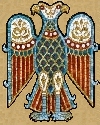 Byzantine Paganism
Byzantine Paganism

 Byzantine Paganism
Byzantine Paganism

Aspects of Late Classical Religion
Click on a title below to visit a section of the Byzantine Pagan site:
![]()
Home
~
History ~
Rituals ~
Priesthood
Documents ~
News
~
Forum ~
Shop ~
Links
~
FAQ
![]()
|
The Lararium - the Household Altar There were many forms of household altar in the Greco Roman world, depending on one's living circumstance. Wealthy households might have a large standing altar, more modest homes might have a simple stand or shelf where one could put small statues, a lamp and an offering dish. The home altar was usually located in the front room of the home, or sometimes in the kitchen. After the reign of Emperor Constantine I it became more dangerous to have an obvious altar setup in one's home... unless it was a personal Christian shrine! Some pagans disguised their Lararium by decorating it with Christian-like icon images that were really images of the ancient Goddesses and Gods. For instance, an image Minerva could be disguised as a female saint by "hiding" some of her symbols (such as an owl, tools for weaving, etc) in an icon that might otherwise look Christian. Other Classical worshipers must have simply hidden their home shrine by separating its various parts and tools when not in use. Most altar tools could double as kitchen items and be kept in a room separate from the altar table. Lararium Ritual Tools The ritual tools for a private altar consist of: Imago: Image or statue of the deity (if available). In Byzantium this was sometimes a painted image disguised as a Christian icon. Focus: This was the cup-shaped top of a roman altar where offerings were placed. This can be a dish (usually stone or clay) where any offering (food, flowers, objects given to deity) may be placed. Patera: A low-rimmed dish for offering wine or other liquid. Gutus: A small jug for holding wine or other liquid to pour into the patera when offering. Lucerna: Lamp for the sacred flame usually an oil lamp, but can be substituted by a white candle. Accerra: A box to hold incense Salinum: A box to hold salt Mola Salsa: A mixture of spelt flour and a small amount of salt,
mixed with water to a paste, and dried into small, thin wafers around the size
of a coin. These are small purified cakes to be offered to the Gods. Mola
Salsa cakes should be kept fresh, and brought to the Lararium only when a rite
is being done.
|
© Copyright Byzantium Novum, 2022